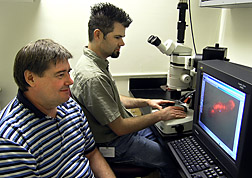For Innovative Pest Control, a New Gene-Transfer Technique
|
|
Many crop insecticides have lost effectiveness because the target pests have developed resistance. Others have been discontinued because of the potential or real risks they pose to environmental or human health. The upshot is that growers have fewer chemical options available to them for controlling pest insects.
One highly successful nonchemical alternative to insecticides is the sterile insect technique (SIT), in which masses of male insects are sterilized by irradiation and then released to mate with wild females. No offspring result, and the population diminishes.
SIT could potentially be improved—and new types of biological control developed—by use of genetically modified insects. A genetic tool developed and patented in part by ARS researchers, called the “piggyBac transposon,” is being used to genetically modify many species of pest insects, such as flies, moths, and mosquitoes. Transposons are also called “jumping genes” because they can jump from one place on a chromosome to another. A concern about this genetic modification method, though, is the rare possibility that inserted genes could move again, or “remobilize,” resulting in loss of the desired traits or entry into other organisms.
Before such modified insects are ever tested or used in the field, scientists must be sure any introduced genes stay put.
In an exciting discovery, ARS physiologist Paul D. Shirk and his colleagues at the ARS Center for Medical, Agricultural, and Veterinary Entomology in Gainesville, Florida, have developed a gene-transfer system—a “vector”—that can be used to test foreign gene activity in pest insects without worry that the genetic transformation will pass to the next generation.
This new method uses part of a virus called “JcDNV” to ferry new genes into insects. The process is done by injecting insect embryos with the JcDNV vector, which has been altered so it can’t cause disease. Instead, the vector—carrying the foreign gene—inserts itself into the insect’s chromosomes. The newly installed gene can then be tested during all stages of the insect’s life.
Unlike piggyBac or other transposons, the JcDNV vector enters only the somatic, or body, cells—not the germline, or reproductive, cells—so the next generation will not inherit the genes.
The vector works well for a variety of insects, including flies and moths. It allows testing of lab-constructed foreign genes that could potentially cause sterility in the insect, and there’s no worry that the genes will remobilize.
The JcDNV vector came from a parvovirus, Junonia coenia densovirus, which infects the common buckeye butterfly, Junonia coenia. Max Bergoin, a virologist who originally cloned the JcDNV parvovirus in his laboratory at the University of Montpellier in France, collaborated with Shirk in the vector research. Other team members included postdoctoral researchers Herve Bossin and Jennifer Gillett and ARS technician Richard Furlong.—By Jim Core, formerly with ARS.
This research is part of Crop Protection and Quarantine, an ARS National Program (#304) described on the World Wide Web at www.nps.ars.usda.gov.
Paul D. Shirk is in the Insect Behavior and Biocontrol Research Unit, USDA-ARS Center for Medical, Agricultural, and Veterinary Entomology, 1600 S.W. 23rd Dr., Gainesville, FL 32608; phone (352) 374-5720, fax (352) 374-5804.
"For Innovative Pest Control, a New Gene-Transfer Technique" was published in the September 2006 issue of Agricultural Research magazine.







